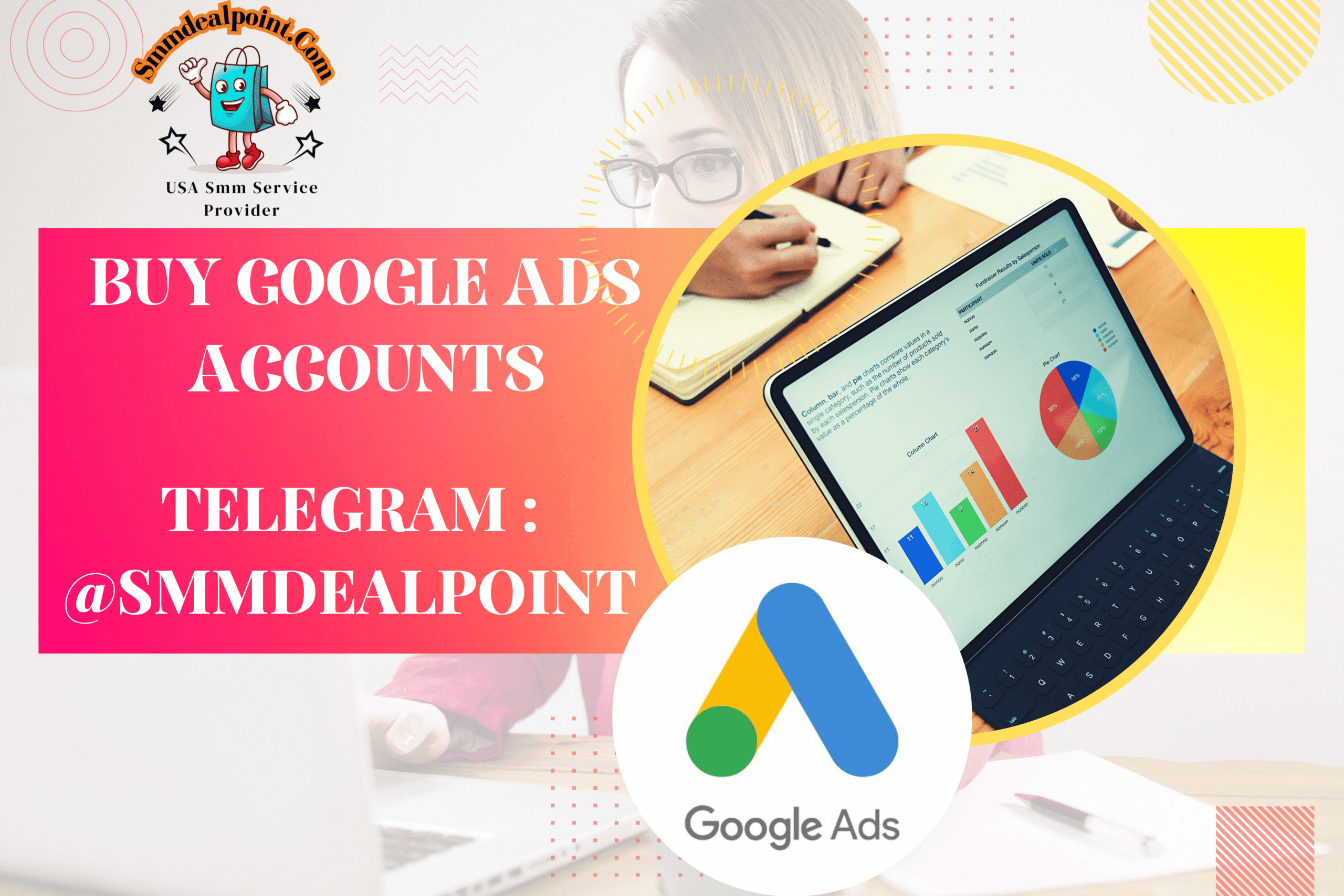Buy Google Ads Accounts
Buy Google Ads Accounts is the backbone of paid search and display advertising for businesses of all sizes. It’s tempting for some to shortcut onboarding by buying “pre-verified” accounts or accounts with existing history — but that’s risky, violates Google’s Terms of Service, and often ends in suspended ad accounts and lost money. This guide walks you through the right way to set up, verify, secure, and scale Google Ads accounts—covering Manager Accounts (MCC), billing and verification, account structure, campaign best practices, policy compliance, security, and how to recover from suspensions. Follow these steps to build resilient ad programs that last.
Keywords: Google Ads account, verify Google Ads, Manager Account, ad account security, Google Ads suspension
Why you must never buy Google Ads accounts
Buying or accepting someone else’s Google Ads account poses immediate and long-term dangers:
-
Policy violation & suspension: Google expressly forbids account trading. If detected, Google will suspend the account and may ban related accounts.
-
Frozen budgets & spend loss: Suspensions often lock remaining budgets and can halt campaigns mid-flight, causing wasted spend and lost opportunities.
-
Bad reputation & history: Purchased accounts may carry poor-quality history, bad ad practices, or policy violations that hurt performance and increase scrutiny.
-
No reliable recourse: Sellers can reclaim access, change billing, or provide stolen payment methods, leaving buyers with no remedy.
-
Legal & tax issues: Using another entity’s advertising account can create tax and contractual complications, especially for regulated industries.
The safe path is to create and verify your own accounts and, if you need agency help, use Manager Accounts (MCC) to manage client accounts without transferring ownership.
 Buy Google Ads Accounts types & Manager (MCC) accounts
Buy Google Ads Accounts types & Manager (MCC) accounts
Understand the differences so you choose the right structure:
-
Individual Google Ads account: One advertiser’s campaigns, billing, and settings. Ideal for single brands or small businesses.
-
Manager Account (MCC): A multi-client account that links multiple individual Google Ads accounts. Agencies and in-house teams use MCCs for centralized reporting, access control, and streamlined billing. An MCC manages accounts without owning them—this preserves client ownership and compliance.
-
Google Ads Editor & API: Tools for offline editing and automation; use them with proper API credentials and account-level permissions.
Use an MCC if you manage multiple clients; link client accounts via invitation rather than importing or buying accounts.
Step-by-step: Create and verify a new Google Ads account (legitimate)
-
Set up a Google Account: Use a business email (G Suite/Google Workspace is best) for better admin controls and company ownership. Avoid personal or disposable emails.
-
Go to ads.google.com and create a new Google Ads account: Follow the guided creation—set billing country, time zone (important; can’t be changed), and currency. These determine tax and billing behavior.
-
Select business objective and campaign type: You can skip the automated “goal-based” setup and use Expert Mode if you prefer full control.
-
Add payment method & billing details: Enter a legit payment method (company card, bank account, or monthly invoicing for qualifying customers). Make sure the billing name matches legal business name.
-
Verify identity if prompted: Google may ask for business documents or identity verification for higher spend, for sensitive verticals (finance, healthcare), or region-specific regulations (e.g., political ads). Provide requested documents via Google’s secure flow.
-
Set up conversion tracking and analytics: Install Google Ads conversion tags, Google Analytics 4 (GA4), or server-side tracking to measure performance accurately.
-
Enable account-level security: Turn on 2-Step Verification for the Google Account that owns billing and admin access. Use role-based access for colleagues or agencies via IAM (Account → Access).
-
Link to Manager Account (optional): If an agency needs access, invite their MCC to manage rather than transferring account ownership.
Document the account owner, billing contact, and tax identifiers to prevent future recovery headaches.
Billing, payment methods & tax considerations
Billing is a frequent source of account issues—set it up right:
-
Payment method options: Google supports credit/debit cards, bank transfer (for select regions), and monthly invoicing for eligible advertisers. For new advertisers, cards are the simplest.
-
Billing country & currency: These are permanent settings; choose carefully based on your legal entity location and invoicing requirements.
-
Tax & invoicing: Add VAT/GST numbers where applicable; request invoices in your account’s billing settings and keep records for tax filing.
-
Dispute & chargeback management: Use documented receipts and invoices. If a payment dispute arises, Google Support can provide transaction details—keep your finance contact and billing emails monitored.
-
Billing thresholds: Prepay (automatic charges) or postpay (monthly invoices) behaviors vary by region and payment history—maintain healthy payment records to qualify for higher thresholds.
Always use company-owned payment methods tied to the legal advertiser to avoid disputes and potential suspensions.
Account structure: campaigns, ad groups, keywords & assets
A clean structure improves performance and scale:
-
Organize by business goals: Create separate campaigns for brand awareness, acquisition, and retargeting, each with its own budget and bidding strategy.
-
Ad groups are for tightly themed keywords: Each ad group should target a tight set of keywords and a matching ad message.
-
Match types & negative keywords: Use exact, phrase, and broad match carefully. Maintain negative keyword lists at campaign or account level to minimize wasted spend.
-
Ad assets & extensions: Use responsive search ads (RSAs), sitelinks, callouts, and structured snippets to improve CTR and ad rank.
-
Use SKAGs sparingly: Single Keyword Ad Groups (SKAGs) were popular but add management overhead—balance granularity with scale.
-
Naming conventions & labels: Use clear naming for campaigns and labels for reporting (e.g., channel, product, audience). This helps automation and reporting.
Document structure and maintain templates for repeatable builds.
Creative, landing pages & Quality Score
Good creative + relevant landing pages = higher Quality Score and lower CPC:
-
Ad relevance & messaging: Ensure headlines and descriptions reflect the searcher intent and include primary keywords.
-
Landing page experience: Fast page load, mobile-optimized UX, visible CTA, and clear privacy/payment info improve conversion rates and satisfy policy checks.
-
Quality Score components: CTR, ad relevance, and landing page experience matter—monitor them at the keyword level and optimize accordingly.
-
A/B test creatives: Use ad variants and responsive assets to let Google optimize combinations.
A strong landing page with clear conversion tracking is critical to prove performance and avoid policy concerns.
Policy compliance: what triggers suspensions
Google enforces strict policies. Common violation areas:
-
Misrepresentation: Landing pages that mislead, display false claims, or hide critical details.
-
Restricted content: Ads for gambling, healthcare, financial offers, cryptos, or political content often require certification and compliance steps.
-
Malware/malicious behavior: Sites that contain malware, violate user privacy, or auto-download files get immediate rejections and suspensions.
-
Circumventing review: Spinning content, cloaking, or using deceptive redirects to pass review will lead to account-level action.
-
Unpaid invoices or billing issues can also result in limited ad serving.
Always read Buy Google Ads Accounts policies, implement required certifications (e.g., Cert for financial services), and pre-check landing pages using Google’s policy tools in the account.
Security best practices (Buy Google Ads Accounts & access)
Protecting your ad account prevents hijacks and misuse:
-
Owner email control: Use a company-owned Google Workspace account for the primary owner and billing contact. Avoid employee personal accounts as the single owner.
-
Enable 2-Step Verification (2SV) and enforce it for all admins. Consider security keys (FIDO2) for critical users.
-
Grant least privilege: Use Admin, Standard, or Read-only roles—don’t provide full admin rights if not needed.
-
Audit access regularly: Review user list and revoke stale permissions monthly.
-
Secure API keys & scripts: Rotate credentials, use restricted scopes, and store secrets safely.
-
Monitor change logs: Google stores change history—use it to audit who changed bids, creatives, or billing.
A compromised account can cause massive immediate spend—prevention is far cheaper than recovery.
Scaling: automation, scripts & smart bidding
Scale carefully and measure:
-
Start with manual bidding, then test automated strategies: Smart Bidding (Target CPA, Target ROAS) performs well when conversion data is stable.
-
Use rules & scripts: Automate low-risk tasks—pause underperforming ads, adjust bids on schedule, or implement dayparting.
-
Audience signals & data feeds: Use remarketing lists, customer match, and first-party data to inform bidding.
-
Test incrementally: Use experiments and drafts to validate changes before full rollout.
Maintain guardrails—auto-bidding without conversion tracking or with poor data can blow budgets.
Suspension recovery & appeals
If your account is suspended:
-
Read the suspension notice carefully: Google typically states the reason (policy, billing, repeated violations).
-
Fix root causes: Remove policy-violating ads, update landing pages, resolve billing issues. Don’t submit vague appeals.
-
Document remediation steps: Keep screenshots, change logs, and tests proving compliance.
-
Use the official appeal form: Provide a clear timeline of fixes and evidence. Repeated frivolous appeals can harm prospects of reinstatement.
-
If needed, escalate using Google representative contacts (if you have a dedicated rep) or via Google Ads Support channels.
Prevention is better—regular policy audits reduce the chance of suspension.
 Reporting, attribution & measurement
Reporting, attribution & measurement
Accurate measurement powers optimization:
-
Use Google Tag Manager & GA4: Centralize tags for consistency and safeguard tracking when pages change.
-
Server-side tracking & conversions API: Improve cross-browser measurement and reduce data loss.
-
Multi-touch attribution: Evaluate last-click vs data-driven models to understand real performance.
-
Export data to BI: Connect to BigQuery or other BI tools for deeper analysis.
Clean data = better automated bidding and smarter budget allocation.
FAQs (short & SEO-friendly)
Can I Buy A Google Ads Accounts from someone else?
No. Buying accounts violates Google Ads Terms of Service and risks suspension, frozen budgets, and loss of access.
How long does identity verification take?
It varies—some verifications are instant; others (manual review, business docs) can take several business days.
What should I do if my billing is declined?
Update payment method, check card country/currency match, ensure sufficient funds, and contact Google billing support.
Why was my ad disapproved?
Check the policy reason in the Ads UI, fix the landing page or ad, and resubmit. Keep detailed change notes.
Conclusion
Shortcuts like Buying Google Ads Accounts promise speed but deliver risk—suspensions, frozen budgets, and damaged reputations. Build ad programs the right way: create and verify your own accounts, secure owner access with company-controlled emails and 2SV, structure campaigns around business goals, verify billing and tax details, maintain strong landing pages, and follow Google’s policies. If you manage multiple clients, use a Manager (MCC) account to avoid transferring ownership. With thoughtful setup and continuous policy hygiene, your Google Ads investments will scale reliably and sustainably.


Reviews
There are no reviews yet.